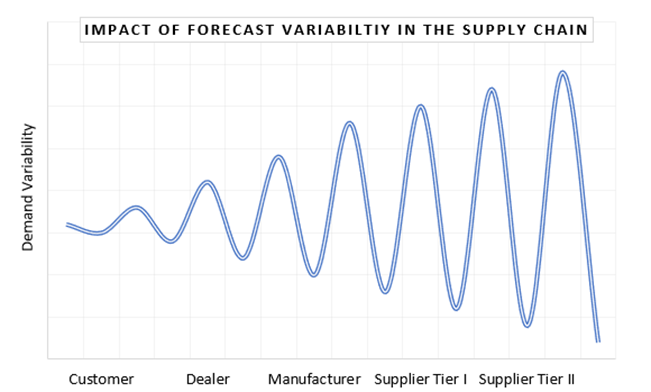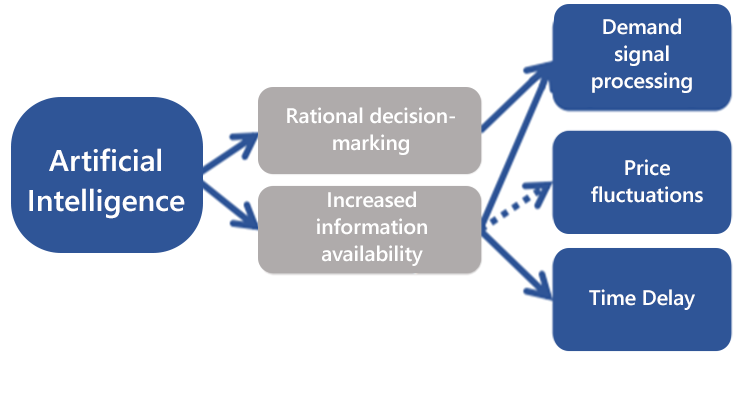The Impact of Forecast Variability on Supply Chain Performance
Publish Date: November 20, 2020It is generally accepted that supply chains will be vastly different in the years to come. Many emerging technologies and advanced analytics have failed to address the issues of demand variability resulting in the bullwhip effect within the supply chain. The traditional approach of safety stock or inventory buffers are being challenged with an ever-increasing focus on supply chain costs. How can supply chain professionals maintain the required delivery and availability service levels moving forward?
The Louis L’Amour quote that “the only thing that never changes is that everything changes,” applies perfectly to forecasts and demand signalling. The increased network complexity, cost pressure, and customer expectations combine to put enormous pressure on supply chain organizations to get it right.
The crucial need is for enhanced transparency and stronger partner relationships to successfully collaborate requirements to create a resilient and responsive supply chain even through the forecast variability. In this blog we address a few key points on how technology can and cannot help to reduce the variation of critical demand signals.
The Bullwhip Effect
As seen from the figure below, the greater order variability placed by the customer to the upstream stakeholders contributes to the bullwhip effect. If you consider the X-axis to represent lead-times than the challenges have become how to decrease the level of variability impact throughout the supply chain as it becomes increasingly more significant.

This is where transparency can help resolve the limited visibility pattern downstream. If suppliers had access to the customer demand fluctuations in real-time and trusted the accuracy of the signal their reaction time to change can be reduced. In turn limiting the impact of the bullwhip effect to their operations.
Demand will fluctuate – measure your accuracy
Demand will fluctuate, this is unavoidable but the increased volatility to the supply chain needs to be minimized. Having a robust set of Key Performance Indicators (KPIs) integrated into your Sales, Inventory and Operations Planning (SIOP) or Sales and Operations Planning (S&OP) processes are critical link to first understand if the demand is accurate to the plan.
This eliminates the delayed reaction to address the issues, which typically result in your critical supplier notifying you your forecast had significant changes. The classic supplier conversation, “I just re-ran MRP and the demand should be fixed. Please check your EDI tomorrow.” If you asked your suppliers to rate your forecast accuracy, what would they say? If you want your suppliers to execute at a high level, it starts with trusting and building your suppliers confidence in your own forecast processes.
Focus your efforts to maximize your return
Measuring accuracy and building confidence in the forecasts becomes a daunting task even with the available data and technologies. You can reduce efforts, by funnelling your focus to those suppliers or components that are most critical to your operations. Besides, safety stock carry costs and long lead-time components consider using historical supplier delivery performance, operational impact (line stoppage or minor repair), severity of a stock out and required service level to support production.
This will also aid in your efforts to implement a technology solution to ensure accuracy and volatility KPIs are easily extracted and managed, building confidence in your demand signalling at the most crucial levels.
Use technology to make sense of demand signals
Effective demand signal management is at the core of a demand-driven supply chain. Technologies today allow us to capture data in real-time. We can combine it with internal data and intelligent analytics to further understand, assess and act on the demand signal changes. Providing valuable insights into what, when and where the requirements have changed to react and drive value a crossed the supply chain.
This is where AI-based models, analytics and machine learning enable numerous ways to facilitate and validate demand forecasting across critical business activities. If you take the first two steps listed into consideration, the introduction of such technologies becomes a relatively easy assessment of where and how to apply advanced analytics to control your demand variability. Harmonizing this data in real-time leads to improved demand signal and price fluctuations processing, quicker decision-making in supply chains.

Fig 2: https://www.sciencedirect.com/science/article/pii/S221282711930459
Baselining forecasting, cross-departmental alignment, and integrating end-to-end processes take time, effort and a variety of skillsets. Increased forecast accuracy can lead to increased performance at every handoff of the supply chain. Every organization has variations in their processes just like every forecast has some level of error, but those organizations that that focus on reducing the variability impact can delivery constant value to the business. Now is the time with the available tools and technology to start thinking about the impact poor forecast accuracy has on your customers and business partners.




